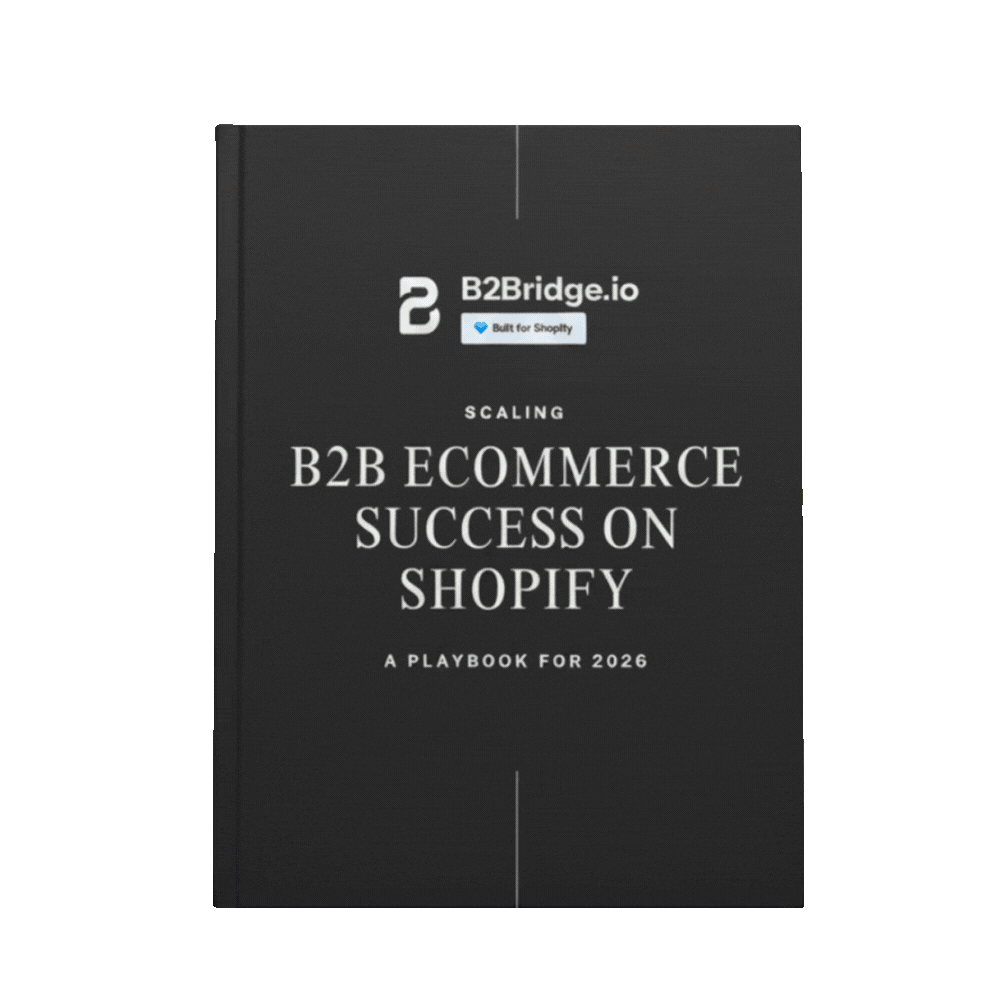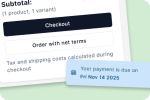B2B payments are financial transactions between businesses for goods, services, or intellectual property. Unlike consumer payments, B2B transactions involve larger values, multi-step approvals, complex contractual terms, and extended payment cycles.
The global real-time payments market, a vital segment of B2B payments, was valued at $24.91 billion in 2024 and is projected to grow at a CAGR of 35.4% from 2025 to 2032. Streamlining B2B payments is essential for operational efficiency, cash flow management, and enabling seamless global trade in today’s interconnected business landscape.
What’s in this article?
- What Are B2B Payments?
- What Is the Difference Between B2B and B2C Payments?
- What are the Types of Payments for B2B?
- Pros and Cons of B2B Payment Methods
- Cross-border B2B payment challenges and solutions
- Emerging Trends and Innovations in B2B Payments
- Real-World Case Studies of B2B Payments
- Best Practices for Managing B2B Payments
- How B2Bridge Can Help
- FAQs about B2B Payments
What Are B2B Payments?
B2B payments encompass all financial transactions conducted between businesses, including both one-time purchases and recurring payments. These transactions facilitate the exchange of goods, services, raw materials, software licenses, consulting services, and other business-essential resources that keep operations running smoothly.
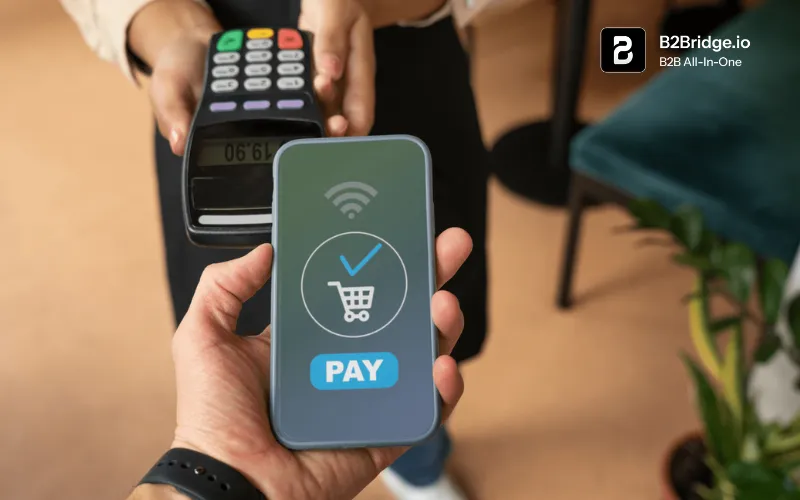
The typical B2B payment workflow involves several coordinated steps. It begins with purchase order issuance where the buyer formally requests products or services. The supplier then delivers the goods and submits an invoice detailing the transaction terms. The buyer’s finance and procurement teams review and approve the invoice, verifying that delivered items match the purchase order. Once approved, payment is processed according to agreed terms – often net 30, 60, or 90 days. Finally, both parties perform reconciliation, matching payments to invoices in their accounting systems.
Multiple stakeholders participate in B2B payment processes across different organizational functions. Finance teams manage payment execution, cash flow planning, and financial reconciliation. Procurement departments negotiate payment terms, select vendors, and issue purchase orders. Accounting teams handle invoice processing, payment verification, and financial record-keeping. This cross-functional involvement adds layers of complexity but provides necessary controls for high-value transactions.
Modern B2B payments increasingly leverage technology to automate workflows, reduce manual errors, and accelerate transaction speeds. Digital platforms integrate with enterprise resource planning (ERP) systems, accounting software, and banking infrastructure to create seamless payment experiences. Real-time tracking, automated approvals, and electronic reconciliation replace paper-based processes that historically dominated B2B commerce.
What Is the Difference Between B2B and B2C Payments?
B2B and B2C payments serve fundamentally different purposes and operate under distinct frameworks. Understanding these differences helps businesses implement appropriate payment strategies and select suitable technologies.
| Aspect | B2B Payments | B2C Payments |
| Transaction Size | Typically larger ($1,000 – $1,000,000+) | Usually smaller ($10 – $500) |
| Approval Process | Multi-level approvals, multiple stakeholders | Single-person decision, instant checkout |
| Payment Timing | Extended terms (net 30, 60, 90 days) | Immediate payment at purchase |
| Payment Methods | Wire transfers, ACH, checks, corporate cards | Credit/debit cards, digital wallets, buy now pay later |
| Contractual Terms | Formal contracts, purchase orders, negotiated terms | Standard terms and conditions |
| Invoicing | Detailed invoices required with line-item descriptions | Simple receipts or order confirmations |
| Credit Availability | Trade credit, net terms, credit lines common | Limited installment options |
| Relationship Duration | Long-term partnerships, repeat transactions | Often one-time or sporadic purchases |
| Documentation | Extensive (POs, invoices, receipts, contracts) | Minimal documentation required |
| Reconciliation | Complex matching of POs, invoices, payments | Automated, straightforward reconciliation |
B2B payments often require purchase orders that formally authorize transactions before any goods or services change hands. These documents specify quantities, prices, delivery terms, and payment conditions. Suppliers reference purchase order numbers on invoices, creating an audit trail that supports financial controls and facilitates reconciliation.
Payment terms significantly differentiate B2B from B2C transactions. Business customers typically receive credit terms allowing payment weeks or months after receiving goods. Net 30 terms mean payment is due 30 days after the invoice date. Early payment discounts (e.g., 2/10 net 30) offer percentage reductions for accelerated payment. These extended terms impact cash flow management for both buyers and suppliers, requiring careful financial planning.
The complexity extends to approval workflows. B2C consumers make immediate purchase decisions and pay instantly. B2B transactions often require approval from procurement managers, budget holders, finance directors, or even C-level executives depending on transaction value. Multiple stakeholders review purchase justification, budget availability, vendor credentials, and contract compliance before authorizing payment.
Relationship dynamics also differ substantially. B2B partnerships often span years with regular transactions, negotiated pricing, and customized terms. This ongoing relationship context influences payment arrangements, with trusted partners receiving more favorable terms. B2C transactions are frequently anonymous, one-time purchases with standardized pricing and terms for all customers.
What are the Types of Payments for B2B? – B2B Payment Examples
Payment Cards
Corporate credit cards and virtual cards offer convenient payment options for small to medium-sized B2B transactions. Corporate cards provide centralized billing, expense tracking, and rewards programs while maintaining employee spending controls. Virtual cards generate unique, single-use card numbers for specific transactions, enhancing security and simplifying reconciliation.
These cards work well for recurring expenses like software subscriptions, office supplies, travel bookings, and vendor services. Integration with expense management platforms automates categorization and approval workflows. However, processing fees (typically 2-3%) make cards less economical for large transactions, and some suppliers don’t accept card payments due to these costs.
Bank Transfers
Bank transfers remain the backbone of B2B payments, particularly for high-value transactions. Automated Clearing House (ACH) transfers in the United States offer cost-effective electronic funds movement, typically completing within 1-3 business days. Wire transfers provide same-day settlement domestically and are standard for international payments, though they carry higher fees.
Direct credits enable businesses to push payments to supplier bank accounts on scheduled dates, supporting predictable cash flow management. Bank transfers provide strong audit trails, low per-transaction costs for large amounts, and universal acceptance. The primary drawbacks include slower processing times compared to cards and higher costs for international wire transfers with currency conversion.
Cheques
Despite digital alternatives, cheques persist in B2B payments due to familiarity, detailed audit trails, and perceived security. Organizations value the physical documentation and the payment hold period allowing final verification before funds transfer. Industries with conservative payment practices or specific regulatory requirements maintain cheque usage.
However, cheques introduce significant inefficiencies: manual processing time, physical handling and mailing costs, delayed availability of funds, and increased fraud risk through alteration or counterfeiting. Progressive businesses increasingly abandon cheques in favor of electronic methods offering faster processing and better security.
Cash
Cash transactions are rare in modern B2B commerce but occasionally appear for immediate settlement needs, very small purchases, or informal business relationships. Construction suppliers might accept cash for emergency material pickups. Small vendors at trade shows may prefer cash for minor transactions.
Cash offers instant settlement without processing fees but lacks security, creates reconciliation challenges, provides no automatic audit trail, and proves impractical for transactions beyond trivial amounts. Digital payment alternatives have largely eliminated legitimate use cases for cash in formal B2B transactions.
Digital Payment Platforms
PayPal, Stripe, Square, and emerging fintech solutions provide digital B2B payment capabilities combining ease of use with automation features. These platforms facilitate online payments, subscription billing, and integration with Ecommerce systems. APIs enable custom payment experiences embedded in business applications.
Digital platforms offer faster settlement than traditional bank transfers, simplified international payments, and user-friendly interfaces requiring minimal technical expertise. However, some platforms lack robust B2B-specific features like purchase order matching, complex approval workflows, or comprehensive ERP integration that enterprise businesses require.
Purchase Orders and Invoices
While not payment methods themselves, purchase orders and invoices are essential documents governing B2B payment authorization and record-keeping. Purchase orders formally communicate buying intent, specify terms, and authorize suppliers to fulfill orders. Invoices request payment and provide transaction details for accounting purposes.
The purchase order-to-invoice-to-payment cycle creates a structured process ensuring both parties agree on transaction terms before payment occurs. Modern systems digitize these documents, enabling electronic workflows, automated matching, and seamless integration with accounting platforms.
Pros and Cons of B2B Payment Methods
| Payment Method | Advantages | Disadvantages |
| Payment Cards | Fast processing; rewards programs; simplified reconciliation; strong fraud protection | High processing fees (2-3%); lower acceptance among suppliers; transaction limits may apply |
| ACH Transfers | Low cost; reliable; automated scheduling; suitable for recurring payments | Slower processing (1-3 days); limited international capability; requires bank account details |
| Wire Transfers | Same-day settlement; works internationally; high transaction limits; universal acceptance | Expensive fees ($15-50+ per transaction); irreversible; manual initiation required |
| Cheques | Detailed audit trail; payment hold period; familiar to all parties; no processing fees | Slow processing; manual handling; fraud vulnerability; physical mailing required |
| Cash | Instant settlement; no processing fees; simple for small amounts | No audit trail; security risks; impractical for large amounts; reconciliation challenges |
| Digital Platforms | User-friendly interfaces; fast settlement; API integration; good for online payments | May lack B2B features; transaction fees; limited ERP integration; platform dependencies |
Selecting appropriate payment methods requires evaluating transaction characteristics, relationship dynamics, and operational priorities. High-value, recurring payments between established partners favor ACH transfers balancing cost and reliability. Time-sensitive international transactions justify wire transfer expenses. Smaller, frequent purchases suit corporate cards despite processing fees when convenience and rewards offset costs.
Many businesses adopt multi-method strategies, using different payment types for different scenarios. A manufacturer might pay raw material suppliers via ACH, use corporate cards for software subscriptions, and execute wire transfers for international equipment purchases. This tailored approach optimizes cost, speed, and convenience across diverse payment needs.
Problems with Cross-Border B2B Payments and Solutions
Key Challenges
Cross-border B2B payments introduce substantial complexity beyond domestic transactions. Currency conversion creates unpredictability as exchange rates fluctuate between order placement and payment execution, potentially eroding profit margins or inflating costs. Businesses struggle to forecast exact payment amounts when values shift daily.
Regulatory compliance varies dramatically across jurisdictions. Anti-money laundering (AML) regulations, know-your-customer (KYC) requirements, tax reporting obligations, and payment restrictions differ by country. Navigating this regulatory patchwork requires specialized expertise and careful documentation to avoid penalties or transaction rejections.
Hidden fees plague international payments. Beyond stated transaction charges, banks impose intermediary fees, correspondent bank fees, currency conversion markups, and receiving fees that compound costs significantly. Lack of transparency makes it difficult to predict total transaction expenses or compare provider pricing accurately.
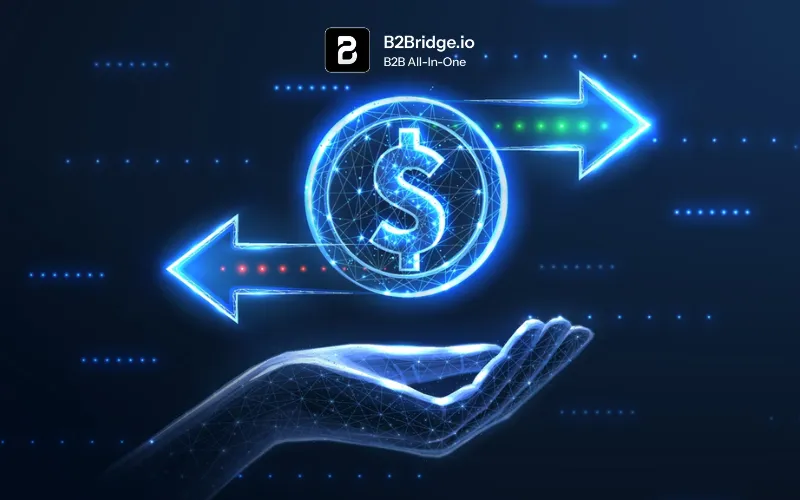
Payment delays frustrate both parties. International wire transfers may take 3-5 business days or longer, complicated by time zone differences, intermediary bank processing, and compliance checks. These delays strain working capital, create uncertainty about payment receipt, and complicate cash flow planning.
Multi-party transactions involve correspondent banks, intermediary banks, currency exchanges, and local clearing systems. Each participant adds processing time, potential error points, and additional fees. Tracking payment status through this chain proves difficult, leaving businesses uncertain whether payments succeeded or encountered problems.
Lack of transparency makes international payments opaque. Senders cannot easily track payment progress, confirm exchange rates applied, or identify where fees accrued. Recipients struggle to reconcile received amounts against expected payments when various deductions occur throughout the payment chain.
Modern Solutions
Payment automation platforms with robust API capabilities enable businesses to integrate international payments directly into ERP systems, accounting software, and workflow applications. Automation eliminates manual data entry errors, accelerates processing, and provides programmatic access to payment status and tracking information.
Real-time payment rails are expanding globally. The UK’s Faster Payments, Europe’s SEPA Instant Credit Transfer, India’s UPI, and similar systems in other countries enable near-instantaneous cross-border settlements between participating institutions. These networks dramatically reduce payment times from days to seconds.
Improved compliance technology leverages artificial intelligence and machine learning to automate KYC verification, sanctions screening, and regulatory reporting. Advanced platforms maintain updated regulatory requirements across jurisdictions, automatically applying appropriate compliance checks and generating required documentation.
Transparent pricing models from modern payment providers clearly disclose all fees upfront. Fintech companies like Wise (formerly TransferWise), Airwallex, and others display exact costs, exchange rates, and expected delivery times before transaction submission. This transparency enables accurate cost comparison and budget planning.
Blockchain and distributed ledger technology promise revolutionary improvements in cross-border payments. Blockchain enables direct party-to-party transfers without intermediary banks, reducing costs and accelerating settlement. Smart contracts automate compliance checks and payment execution based on predefined conditions. While still emerging, blockchain pilots demonstrate significant potential for transforming international B2B payments.
Multi-currency accounts allow businesses to hold balances in various currencies, eliminating conversion needs for each transaction. Companies receiving payments in euros, pounds, and dollars can maintain separate currency balances, paying international suppliers in their local currency directly from appropriate accounts.
Emerging Trends and Innovations in B2B Payments
Automation and Artificial Intelligence
AI-powered payment processing transforms B2B transactions through intelligent automation. Machine learning algorithms detect anomalies suggesting fraudulent invoices, duplicate payments, or processing errors before execution. Natural language processing extracts data from unstructured invoices, automatically populating payment systems without manual entry.
Predictive analytics forecast cash flow needs, optimize payment timing to capture early payment discounts while maintaining adequate liquidity, and identify patterns suggesting vendor financial distress. Robotic process automation handles repetitive tasks like invoice matching, approval routing, and reconciliation, freeing finance teams for strategic activities.
AI chatbots assist with payment inquiries, providing instant status updates and resolving common issues without human intervention. These intelligent systems learn from historical patterns to recommend optimal payment methods, timing, and terms for different vendor relationships and transaction types.
Instant Payments
Real-time payment networks are proliferating worldwide, enabling immediate funds availability. Beyond consumer convenience, instant B2B payments unlock working capital, eliminate payment uncertainty, and support just-in-time business models. The Federal Reserve’s FedNow service in the United States joins existing instant payment systems in over 50 countries.
Instant payments particularly benefit supply chains where rapid payment enables suppliers to release goods immediately, accelerating inventory turnover. Small suppliers facing cash flow constraints receive funds instantly rather than waiting weeks, improving their financial stability and relationship with buyers. Dynamic discounting programs leverage instant payments, offering graduated discounts based on how quickly buyers pay.
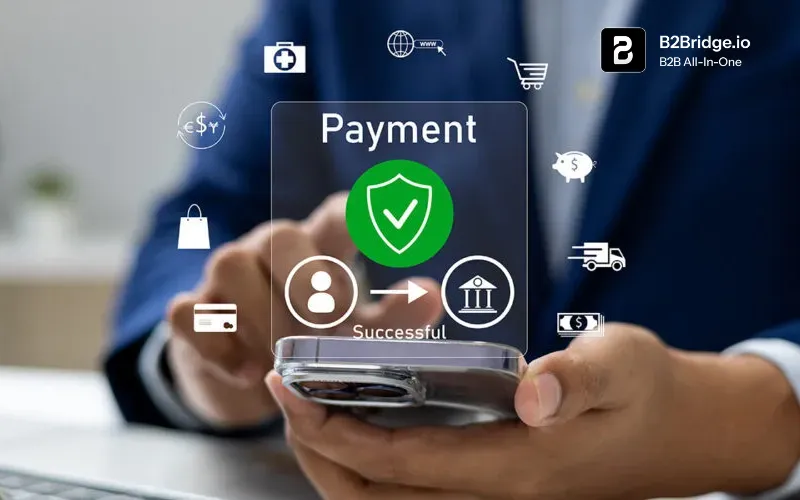
Blockchain and Distributed Ledgers
Blockchain technology enhances transparency by creating immutable payment records visible to authorized participants. Every transaction, fee, and status change is permanently recorded, eliminating reconciliation disputes. Smart contracts automatically execute payments when predefined conditions are met – goods delivered, quality inspected, documents submitted – without manual intervention.
Cross-border blockchain payments bypass traditional correspondent banking networks, dramatically reducing costs and settlement times. Cryptocurrency and stablecoin options provide alternatives to traditional currency transfers, though regulatory uncertainty and volatility concerns limit mainstream adoption. Permissioned blockchain networks designed specifically for B2B transactions balance transparency benefits with privacy requirements.
Data Analytics and Intelligence
Advanced analytics transform payment data into strategic insights. Businesses analyze payment patterns to negotiate better terms, identify early payment discount opportunities worth capturing, and optimize working capital allocation. Vendor analytics reveal payment behavior patterns, highlighting reliable suppliers versus those with frequent billing errors.
Fraud prevention analytics detect unusual patterns suggesting compromised accounts, invoice manipulation, or payment diversion schemes. Benchmarking analytics compare payment performance against industry peers, identifying efficiency improvement opportunities. Cash flow forecasting uses historical payment data combined with pipeline information to predict future liquidity needs accurately.
Embedded Finance
Payment functionality increasingly embeds directly into business software platforms rather than requiring separate payment applications. Procurement systems, ERP platforms, and industry-specific software include native payment capabilities, creating seamless workflows where approving an invoice automatically triggers payment without system switching.
Banking-as-a-service (BaaS) enables non-financial companies to offer payment services embedded in their platforms. Marketplaces facilitate payments between buyers and sellers within their ecosystems. Supply chain platforms manage financing and payments as integrated components of the overall supplier relationship.
Real-World Case Studies of B2B Payments
Case Study 1: Global Manufacturing Company Automates Cross-Border Payments
A manufacturing company with suppliers across Asia, Europe, and South America processed over 5,000 international payments monthly. Traditional wire transfers cost $35-50 per transaction, took 3-5 days to settle, and required manual payment initiation with frequent errors in account numbers or routing codes.
The company implemented an automated cross-border payment platform integrating with their ERP system. The solution automatically converted approved payables into payments, routing them through optimal payment rails based on destination, amount, and urgency. Multi-currency accounts eliminated unnecessary conversions.
Results:
- 70% reduction in per-transaction costs (from $42 average to $13)
- 85% decrease in payment processing time (from 4.2 days to 6 hours average)
- 95% reduction in payment errors through automated data validation
- $890,000 annual savings in transaction fees alone
- Improved supplier relationships through faster, more reliable payments
Case Study 2: B2B ECommerce Platform Enhances Payment Tracking
A wholesale distribution platform connecting thousands of buyers with suppliers struggled with payment visibility. Buyers couldn’t track payment status after submission. Suppliers constantly contacted customer service inquiring about payment arrival. Reconciliation required substantial manual effort matching payments to orders.
The platform integrated a digital payment solution providing real-time tracking, automated reconciliation, and transparent fee disclosure. Buyers received instant confirmation and status updates. Suppliers saw expected payment arrival times and could plan accordingly. Machine learning algorithms automatically matched payments to invoices.
Results:
- 60% reduction in payment-related customer service inquiries
- 40% improvement in customer satisfaction scores related to payment experience
- 95% automated reconciliation rate (up from 45%)
- 30% increase in repeat purchase rates attributed to improved payment experience
- Platform transaction volume growth of 45% year-over-year following implementation
Best Practices for Managing B2B Payments
1. Tailor Payment Methods to Customer Geographies and Preferences
Different regions prefer different payment methods. European businesses commonly use SEPA transfers. Asian suppliers may prefer local payment networks. Understanding and accommodating these preferences improves relationships and may negotiate better terms. Offer multiple payment options allowing customers to choose their preferred method.
2. Invest in Payment System Integration
Disconnected payment systems create inefficiency and errors. Integrate payment platforms with ERP, accounting, procurement, and banking systems. Seamless data flow eliminates manual entry, accelerates processing, improves accuracy, and provides real-time visibility into payment status and cash positions.
3. Maintain Compliance with Evolving Regulations
Regulatory requirements constantly evolve across jurisdictions. Implement processes ensuring ongoing compliance with AML, KYC, sanctions screening, tax reporting, and data protection regulations. Regular audits verify compliance adherence. Technology solutions with built-in compliance features reduce manual oversight requirements.
4. Establish Clear Payment Terms and Communication
Ambiguous payment terms create disputes and relationship friction. Clearly document payment schedules, early payment discount terms, late payment penalties, and dispute resolution procedures. Communicate proactively about payment status, particularly if delays occur. Transparency builds trust and maintains healthy vendor relationships.
5. Leverage Payment Data for Strategic Insights
Payment data reveals optimization opportunities often overlooked. Analyze payment timing to identify discount capture opportunities. Evaluate payment method costs to optimize routing decisions. Monitor days payable outstanding (DPO) relative to industry benchmarks. Use payment performance as a vendor relationship health indicator.
6. Implement Strong Security and Fraud Controls
Payment fraud represents significant risk, with business email compromise and invoice manipulation attacks increasing. Implement multi-factor authentication for payment approvals. Verify banking detail changes through independent channels. Use positive pay services confirming checks before clearing. Monitor for unusual payment patterns suggesting compromised systems.
7. Consider Strategic Payment Timing
Payment timing impacts working capital and vendor relationships. Early payments capturing significant discounts (2% for paying 20 days early equals 36% annualized return) provide excellent returns on excess cash. Conversely, extending payment terms improves working capital when other investments offer lower returns. Strategic payment timing balances these considerations.
8. Develop Strong Vendor Relationships
Collaborative vendor relationships enable negotiation of favorable terms, flexible payment arrangements during cash flow challenges, and priority treatment during supply shortages. Regular communication, reliable payment performance, and fair treatment of disputes foster these partnerships. View vendors as strategic partners rather than transactional counterparties.
How B2Bridge Can Help
Managing complex B2B transactions requires integrated solutions that connect seamlessly across your entire commerce ecosystem. B2Bridge specializes in B2B Shopify solutions designed to simplify operations, enhance customer experiences, and drive business growth. Our app integrates with your existing systems, providing the connectivity and automation that transforms operational complexity into competitive advantage.
Whether you’re looking to optimize your order management workflows, enhance your digital commerce capabilities, or create seamless purchasing experiences for your business customers, B2Bridge delivers the technology and expertise to elevate your B2B operations. Explore B2Bridge solutions or schedule a consultation to discover how we can help transform your B2B commerce experience.
FAQs about B2B Payments
A B2B transaction is a commercial exchange of goods, services, or information between two businesses rather than between a business and individual consumers. These transactions commonly involve larger quantities, higher values, and more complex negotiation and approval processes compared to B2C transactions.
Banking can be both B2B and B2C depending on the customer. When banks provide services to businesses (e.g., business accounts, loans), it is considered B2B. When they cater to individual consumers (e.g., personal accounts, credit cards), it is B2C.
International wire transfers remain standard for large, one-time cross-border payments despite higher costs. For recurring payments, consider specialized international payment platforms like Wise, Payoneer, or Airwallex offering better rates and transparency. ACH transfers work within specific regional networks like SEPA in Europe. Evaluate each option based on speed requirements, transaction size, destination country, and total cost including exchange rates and fees.
Modern payment platforms combining API integration, AI-powered fraud detection, and real-time tracking provide optimal security and efficiency. If you have a Shopify store and you are looking for API integration solution, B2Bridge – All-in-one B2B app can help.
Extended payment terms (net 60, net 90) improve buyer cash flow by delaying cash outflows but strain supplier cash flow. Negotiating favorable payment terms as a buyer provides working capital benefits. Offering early payment discounts balances interests: suppliers receive faster payment while buyers capture discount returns. Dynamic discounting platforms enable flexible, graduated discounts based on actual payment timing rather than fixed early payment dates.
Conclusion
B2B payments represent a critical business function directly impacting cash flow, supplier relationships, and operational efficiency. Success in B2B payment management requires selecting appropriate payment methods for different scenarios, maintaining robust compliance programs, leveraging integration to eliminate manual processes, and treating payments strategically rather than as mere administrative tasks.
As global commerce expands and digital transformation accelerates, B2B payment capabilities will increasingly differentiate market leaders from laggards. Companies embracing innovation, prioritizing payment experience, and implementing best practices position themselves for sustainable growth in an interconnected business ecosystem where efficient, reliable payments enable commerce at every level.
Hi, I’m Ha My Phan – an ever-curious digital marketer crafting growth strategies for Shopify apps since 2018. I blend language, logic, and user insight to make things convert. Strategy is my second nature. Learning is my habit. And building things that actually work for people? That’s my favorite kind of win.
